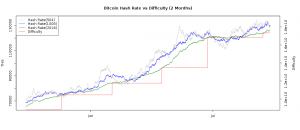With that in mind, you can understand the collective sigh of relief from the mining community heard this Saturday. Mining difficulty rose a mere 3.08%, the lowest percentage seen since the negative growth in February of 2013. For another week and change, making a living from mining bitcoin would be just a touch less harrowing.
The news comes roughly two weeks after one of the largest jumps in mining difficulty history. On June 29, the difficulty rose a staggering 25%, from 13,462,580,115 to 16,818,461,371, instantly making some marginally profitable mining operations fall into the red. With electricity rates already on the rise due to the summer heat, and a new generation of relatively inexpensive, ultra-powerful ASICs flooding the market, a massively rising difficulty was the last thing legacy mining operations needed to face.
It’s not clear why the recent difficulty increase was so small. The difficulty number is automatically generated based on the total number of machines vying to solve the next block, so the obvious conclusion is little new hardware has entered the network since the start of July.














